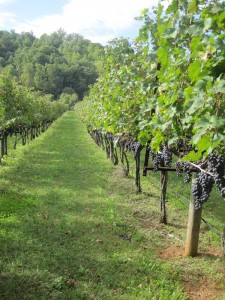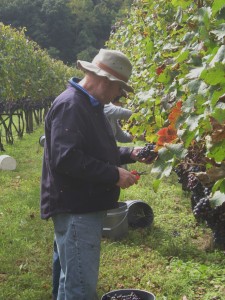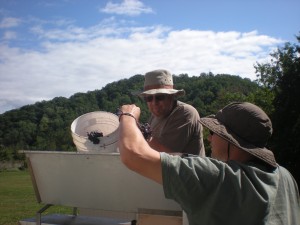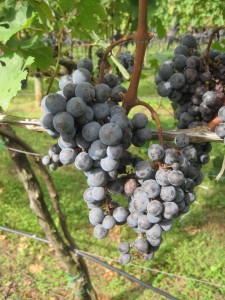Bringing in the Grapes – IV
The harvest is so full of unknowns. You never know exactly when the grapes will ripen – when the pH, Brix, tannins, flavor, and so many other variables will all be perfect – and so vineyard managers study the vines each day as
the growing season nears the end, squeezing juice from a random selection of grapes onto the refractometer, checking the seeds, examining the skins, measuring the pH, tasting the juice, and no doubt thinking, “Why me, God – why do You make me suffer each fall?”
But of course, that’s what makes viticulture the wonder that it is. Each season is different. So much work goes into growing the grapes and then so much judgment and so much hope goes into the decision about when to harvest.
Without a doubt, this has been the most difficult growing season in memory in Virginia. It’s hard enough to fathom out the date when the grapes will achieve the perfect balance of sugar and acid, without the additional complication that comes from weather. Consider this: If the grapes will be perfect on Wednesday, but it rains on Tuesday, then you probably would have been much better off picking on Monday, when they were a few days shy of perfection.
And here’s another twist: if it rains on Sunday and Monday, and the grapes swell from the
precipitation, you might think it wise to wait until Thursday or Friday to give them a chance to recover. If the sun comes out and stays out, you will think yourself a genius. But if it rains again, you may curse your stupidity.
Rain causes so much trouble at harvest. The grapes swell and split, bees attack, and the vineyard is ravaged by sour rot and botrytis. Botrytis is a problem, but it can be dealt with in the winery. Sour rot is different. You can see it and smell it, a sour vinegary odor that is apparent in the juice that breaks out of the berries and covers your hands. It’s best to let those grapes fall to the ground.
Every year brings something new, and this year when we arrived at DuCard Vineyards to pick Cab Franc, it was unseasonably cold. The thermometer read 47 degrees when we woke, and didn’t get above 50 until 8 a.m. At that temperature, it would be hard to get the grapes to begin fermenting, so we waited until 10 a.m., after the morning had warmed up just a bit, to start picking.
And what a glorious day it turned into!
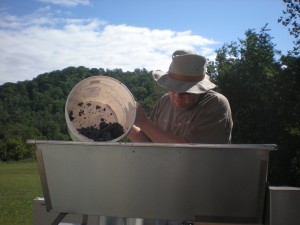
Here's the difference between a good harvest and a bad one -- how you pour the grapes into the crusher. 🙂
As Scott Elliff, owner of DuCard Vineyards said on a recent Saturday, this is what we’ve been working toward all year! This is the harvest – this is the fun part!
He was right. It was like a celebration. We (the Vineyard Goddess and me) spent that day at DuCard picking Cab Franc grapes with a dozen of our friends from viticultural classes at Piedmont Virginia Community College. And while it was work, it was also joyous fun.
Again, this was a difficult vintage, and so we field-sorted the fruit. Anything that looked bad, particularly clusters infested with sour rot, was left on the ground. The rest went into five gallon buckets (the ordinary, inexpensive buckets that you buy from Lowes), which served just as well as the more expensive yellow lugs.
We worked one row at a time, filling buckets and leaving them close to the vines so there was enough room in the row for Scott to pass through with his tractor. As he drove by, we stopped picking for a few minutes to load the buckets into a bin carried on the front of the tractor.
As I’ve noted before, the harvest involved agonizing decisions. We worried we were dropping too much fruit, we worried that we were not dropping enough. If the cluster smelled of vinegar, the choice was ea
sy – it dropped to the ground. If the cluster exhibited signs of Botrytis, the choice was more difficult. It looked bad, but we knew Scott and his superb vineyard manager, Julien Durantie, could deal with Botrytis in the winery.
Around mid-day, I moved from the vineyard to the crush pad, and helped with processing the fruit. I know it looks easy, nothing more than leaning over the crusher-destemmer and letting fruit pour from the bucket, but after 20 minutes, my arms were beginning to feel heavy. And my back had begun to ache. The buckets were heavy, and I was hoisting each new bucket up with one hand, while the other hand dropped an empty bucket to the floor. I poured too fast, and the stems stopped up the destemmer. So I began pouring slowly, and fell behind. I don’t think I ever got it quite right.
Later, back in the vineyard, the bees arrived in force. (Have I mentioned that I’m allergic to bees?) I guess it had finally warmed up enough to make them feel that it would be okay to venture out into the vineyard. And with so many grapes split open and bleeding juice, the vines were a very tempting target for the bees. At one point, I had a bee working the same vine as me, moving from one cluster to another as I dropped each into the bucket. (I’ve mentioned that I’m allergic to bees, haven’t I?) I was surprisingly okay with the bees, despite my allergy, especially this one little guy who was beginning to seem more like a companion than a threat. However, we came to a parting of the ways when it turned out that the stem I thought had gotten caught between my fingers was actually the bee. I knocked him off, and he flew away. I’m not sure if his feelings were hurt.
I believe we harvested a little less than two tons of Cab Franc that day. We were feeling pretty good about our work until Scott told us that a
paid work crew of about half the size of our little band harvested eight tons of Viognier in less time than we spent on the Cab Franc. Of course, the work crew isn’t selective. All of the fruit goes into buckets, and has to be sorted out at the crush pad.
I think Scott was right in saying that the harvest is a joyous occasion. It’s not just the culmination of a season of work and worry, but the start of a journey in which simple grapes are transformed into something noble. In olden times, we’d finish the day arm in arm, starting the crush by dancing in a circle and stomping the grapes with our feet. Today, we use machines to accomplish the same thing. But the romance is still there. We are on the verge of making wine!
Could life be any better?
Category: All Posts, Virginia Wineries, Viticulture, Winemaking

